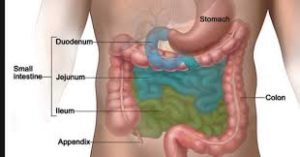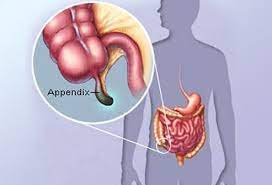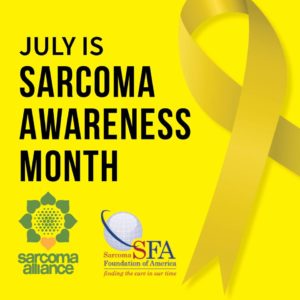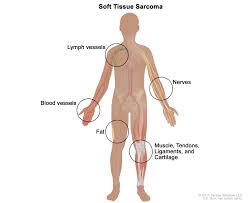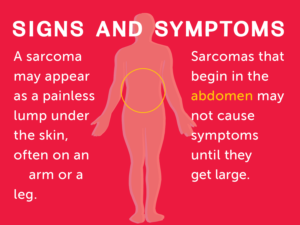
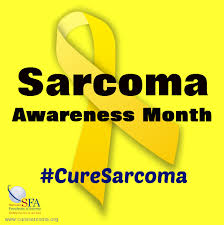
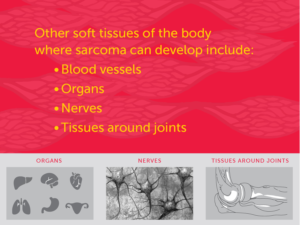
Soft tissue sarcoma symptoms:
Like many forms of cancer, soft tissue sarcoma symptoms may appear at a more advanced stage of the disease, or you might not notice any symptoms at all. Symptoms, if they are present, will also vary depending on the type of sarcoma and its location.
Signs of soft tissue sarcoma include:
A lump or mass is the most common soft tissue sarcoma sign. The lump will form in the area in which the tumor is growing, and it may be accompanied by some pain if it is pressing on a nerve or muscle. Even if the lump isn’t painful, if it continues to grow, or if it is located deep within an extremity or body cavity, consult your doctor.
Uncomfortable swelling is another sign of soft tissue sarcoma, especially when it is located in the arms and legs.
Limited mobility may be a symptom of soft tissue sarcoma. Some tumors can restrict motion, such as those found in the hip, knee, shoulder or hands.
Skin lesions can occur when a sarcoma tumor breaks through the skin.
Other symptoms may be signs of soft tissue sarcoma, because a sarcoma tumor can form almost anywhere in the body and can therefore affect a variety of organs. For example, sarcomas in the abdomen may cause abdominal pain, vomiting or constipation, while sarcomas in the uterus may cause vaginal bleeding and/or abdominal pain. With gastrointestinal stromal tumors (GISTs), you may feel full after eating only very small meals, or you may vomit blood or have dark bowel movements.
Diagnosing Sarcoma:
If your doctor thinks you may have a sarcoma, you’ll probably need a full exam and tests, including: A sample of cells from the tumor, called a biopsy. A plain x-ray to imaging tests, such as a CT scan, an ultrasound, an MRI, a PET (Positron Emission Tomography) to help see inside your body. A bone scan, if you might have osteosarcoma. Also a biopsy-several types of biopsies are used to diagnose sarcomas..
Treatment of Soft Tissue Sarcoma:
Surgery is typically the primary treatment for soft-tissue sarcoma, used to remove tumors. Chemotherapy, radiation therapy and/or targeted therapy may also be recommended, either alone or in combination with surgery, depending on the stage and extent of the disease, along with other factors.
Surgery
The goal of surgery is to locate and completely remove the soft tissue sarcoma tumor. Our pathologists then examine the tumor to determine whether or not additional treatment is necessary, and to reduce the risk of recurrence.
Chemotherapy
Chemotherapy may be used in combination with surgery and radiation therapy to treat advanced-stage soft tissue sarcoma. Chemotherapy drugs work to either destroy cancer cells or impede their ability to grow and reproduce.
At our hospitals, we are developing innovative therapies personalized to the care of each soft tissue sarcoma patient. Our medical oncologists work closely with soft tissue sarcoma patients to determine if chemotherapy is an appropriate treatment option. Throughout your soft tissue sarcoma treatment, your care team continually monitors the effect of chemotherapy on the disease, with physical exams, blood tests, CT scans, MRI scans and chest X-rays and imaging.
Radiation therapy
Depending on the type of soft tissue sarcoma you have and the extent of the disease, your soft tissue sarcoma treatment plan may include radiation therapy. Though surgery is usually the main treatment approach for soft tissue sarcoma, radiation treatments may also be used before (neoadjuvant therapy) or following surgery (adjuvant therapy).
Targeted therapy
Unlike standard chemotherapy drugs, which may affect all cells in the body, targeted therapy drugs are designed to seek out and kill specific cancer cells while sparing surrounding healthy cells. Targeted cancer therapies may be used alone, in combination with other targeted therapy treatments or with other soft tissue sarcoma treatments, such as chemotherapy, radiation therapy and surgery. Among the drugs used in targeted therapy are so-called kinase inhibitors, which target specific protein receptors that help regulate cell growth.


